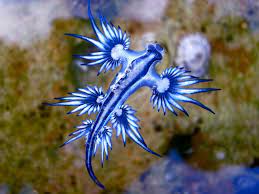Glaucus Atlanticus, commonly known as the Blue Dragon sea slug, is a mesmerizing and enigmatic creature that inhabits the world’s oceans. This tiny sea slug is renowned for its striking blue and silver coloration and its ability to float gracefully on the water’s surface. In this blog, we will delve into the captivating world of Glaucus Atlanticus, exploring its unique physical characteristics, behavior, habitat, and its remarkable adaptation to its marine environment.
I. Physical Characteristics: Glaucus Atlanticus is a small species of sea slug, reaching a length of only a few centimeters. Its body is elongated and flattened, with six appendages on each side, resembling delicate wings. The dorsal side of the slug is a silver-gray color, while its ventral side exhibits a vivid blue hue. This coloration serves as a warning sign to potential predators, indicating the presence of toxins in its body.
II. Habitat and Distribution: The Blue Dragon sea slug is found in various warm and temperate oceans around the world. It primarily inhabits the waters of the Atlantic, Pacific, and Indian Oceans. It is known to drift with ocean currents, which allows it to disperse to different regions and explore a wide range of marine environments.
III. Feeding Habits: Glaucus Atlanticus is a carnivorous predator that preys on other pelagic creatures, such as jellyfish and Portuguese man o’ war. Despite its small size, it possesses a remarkable ability to consume and digest venomous prey, including species that are known for their painful stings to humans. The slug stores the stinging cells from its prey’s tentacles in specialized structures called cnidosacs, using them for its own defense.
IV. Defense Mechanisms: One of the most intriguing features of Glaucus Atlanticus is its unique defense mechanisms. While it may appear harmless, this sea slug is armed with powerful toxins that it acquires from its prey. It stores these toxins in its body, making it dangerous to potential predators. As a result, Glaucus Atlanticus is an example of aposematic coloration, warning predators of its toxicity through its bright blue color.
V. Floatation Abilities: The Blue Dragon sea slug possesses a remarkable adaptation that allows it to float at the water’s surface. By swallowing air and storing it in its stomach, Glaucus Atlanticus becomes buoyant, enabling it to remain afloat effortlessly. This adaptation not only helps the slug move efficiently through the water but also provides protection from potential threats below the surface.
VI. Reproduction and Life Cycle: Glaucus Atlanticus reproduces through internal fertilization, and the female subsequently lays a string of eggs, which she attaches to floating debris or other surfaces. The eggs hatch into larvae, which later develop into adult sea slugs. The life cycle of Glaucus Atlanticus is a testament to the resilience and adaptability of this fascinating species.
VII. Conservation Status: As of now, Glaucus Atlanticus is not listed as endangered or threatened. However, like many marine species, it faces various threats due to human activities, such as pollution, overfishing, and climate change. Conservation efforts are essential to safeguard the delicate marine ecosystems where this sea slug resides.
VIII. Cultural Significance: Throughout history, various marine organisms have captivated human imagination and inspired mythologies and legends. Glaucus Atlanticus, with its otherworldly appearance and unique behaviors, has also become a subject of interest and fascination in human culture, inspiring stories and artwork.
Conclusion: Glaucus Atlanticus, the Blue Dragon sea slug, is a testament to the incredible diversity and wonder of marine life. Its striking appearance, venomous capabilities, and graceful floating abilities make it an intriguing and captivating creature to study and admire. As we continue to explore and learn more about the marine world, let us also strive to protect and preserve the delicate marine environments that are home to such extraordinary species as Glaucus Atlanticus.




















Add Comment